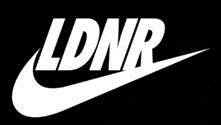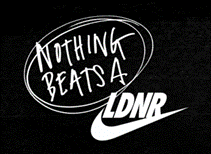October 2, 2018
The claimant, Frank Industries Pty Ltd, owned a UK trade mark and an international (EU) trade mark consisting of the letters “LNDR” registered in respect of “clothing”, including “sportswear”. Frank used the trade marks in uppercase lettering.
In January 2018, the defendant, Nike Retail BV (and other members of the Nike group) embarked on a new advertising campaign in the UK, in which it used the sign “LDNR” in plain text uppercase, primarily as part of the phrases “Nothing beats a LDNR” and “Show you’re a LDNR”, together with two devices, as follows:


Frank contended that Nike had infringed its trade marks and had committed passing off. Nike denied infringement and counterclaimed for a declaration that Frank’s trade Marks were invalidly registered.
Facts
In November 2016, Nike commenced work on a new London marketing initiative, the purpose of which was to engage with London consumers (particularly 16-24 year olds).
As part of the campaign, Nike produced a short film, which showed people wearing Nike clothing and concluded with a screen captioned “SHOW YOU’RE A LDNR” alongside “NIKE.COM/LONDON”. Amongst other things, Nike also used the hashtag #LDNR on social media and erected window displays in its London stores featuring one of the devices and screenings of the film. In addition, the NikePlus page of the Nike UK website displayed one of the devices and “NOTHING BEATS A LDNR” in plain text (together with some text about London). It placed advertising at two Premier League football games, and also placed Google keyword adverts.
It was common ground that LDN was a recognised abbreviation for London. Mr Justice Arnold accepted Nike’s case that younger consumers were in the habit of writing and reading abbreviations in digital forms of communication. However, he said that such abbreviations were only used and understood because the context made the intended meaning clear. The key question in this case was, therefore, how the average consumer would perceive the signs LNDR and LDNR in context.
Validity
Nike contended that LNDR was inherently descriptive as an abbreviation meaning “Londoner”. It relied on posts on Instagram and tweets showing that users were using lndr and LNDR to mean Londoner, and Lndrs and LNDrs to mean Londoners. Mr Justice accepted this, but said that the usage was mainly in hashtag form (usually with other London-related hashtags), and the meaning was generally clear from the context, typically a photograph of a recognisable London landmark or feature and/or captions referring to London.
However, Arnold J found that Nike’s evidence did not establish that LNDR would be perceived by the average consumer as meaning Londoner when used in respect of clothing without some context suggesting that meaning. In other words, LNDR used in relation to clothing was not understood to mean Londoner.
In Arnold J’s view, LNDR was inherently distinctive in relation to clothing as at the relevant dates, and indeed had a moderately strong distinctive character. Accordingly, he rejected Nike’s attack on the validity of Frank’s trade marks.
Infringement under Article 9(2)(b) of the EU Trade Mark Regulation (2017/1001/EU)
Here, Arnold J found that it was plain that that the signs LDNR and LNDR were confusingly similar: it was obvious that the average consumer would be likely to misread and/or mistype and/or mishear and/or misspeak one for the other from time to time.
Further, there was no dispute that, insofar as Nike had used the signs complained of in relation to clothing, then clothing was identical to goods for which Frank’s trade marks were registered.
As for use “in relation to” clothing, Arnold J concluded from the evidence taken from websites and social media that, at the relevant time, LDNR was not an established abbreviation in the way that LDN was. Nevertheless, he said, when used in an appropriate context in digital media, LDNR was used and understood by some consumers to mean Londoner. In addition, LDNR was also used by some traders and understood by some consumers as a brand name for goods. Arnold J therefore had to consider the context(s) in which each of the signs complained of was used.
Looking in detail at Nike’s campaign, Arnold J concluded that, in each case of use, some consumers would perceive LDNR to mean Londoner in the particular context, but some would not. Of those who perceived LDNR to mean Londoner, some would also perceive it as a brand name, he said. Accordingly, Arnold J concluded that Nike had indeed used LDNR “in relation to” clothing. Further, he said that LDNR played an independent distinctive role in, or at the very least was a distinctive component of, each of the devices complained of.
As for a likelihood of confusion, Frank adduced evidence of what it said was actual confusion, which consisted of witnesses who, having seen elements of Nike’s campaign, thought that there was collaboration between Frank and Nike.
Frank also relied on indirect evidence of confusion, which consisted of evidence showing that In the first three to four days after the launch of Nike’s film, the daily traffic to Frank’s website almost doubled and the number of male visitors increased even though Frank did not then offer men’s clothing. Arnold J said that it was difficult to see what other explanation there was for this, other than people visiting the website because they were searching for LDNR clothing and had mistaken LNDR for LDNR. In addition, there was a significant spike in searches on Google for the term LNDR at the time of the campaign. It was likely that this was because consumers had seen the film, or some other element of Nike’s campaign, and had searched for LDNR, but had mistyped it. Although this did not prove that such consumers interpreted LDNR as a brand name, it confirmed LDNR was confusingly similar to LNDR.
Having already found that some consumers would perceive LDNR as a brand name, Arnold J rejected Nike’s defence that, looking at the context in which it had used the signs, the average consumer would perceive LDNR as meaning only Londoner. In Arnold J’s view, there was a likelihood of a significant number of consumers thinking that, as a result of Nike’s use of the signs, there was some form of collaboration between Frank and Nike. The evidence of actual confusion supported this conclusion, he said.
Nike submitted a defence under Article 7(1)(b), contending that LDNR was perceived by the average consumer as denoting some characteristic of clothing. However, Nike did not identify what characteristic of clothing it was supposed to denote.
Nike also argued under Article 7(1)(b) that it had used the signs in accordance with honest practices. Arnold J rejected this argument, finding that Nike had not acted fairly in relation to Frank’s legitimate interests, not least because it knew about Frank’s trade marks before commencing the campaign.
Arnold J concluded that Nike had indeed infringed Frank’s trade marks under s 9(2)(b) of the Regulation. Given that it was common ground that the claim for passing off stood or fell with the claim under Article 9(2)(b), the claim for passing off also succeeded. (Frank Industries Pty Ltd v Nike Retail BV [2018] EWHC 1893 (Ch) (25 July 2018) — to read the judgment in full, click here).
Expertise
Topics